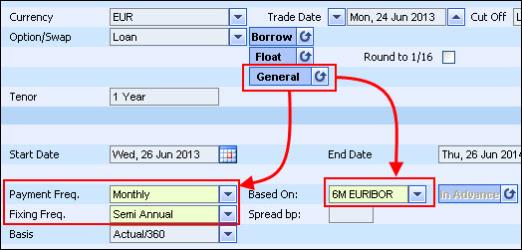
A loan is an instrument whereby the borrower receives an amount of money (principal) from the lender and repays this amount to the lender with interest. The principal can be repaid in one payment on the end date of the loan or repaid in installments over the life of the loan.
According to market convention, in the derivatives market a loan is always revalued without taking into account the principal payment paid/received at the start of the loan.
Pricing a Loan in SDX Interest Rates
Currently in SDX Interest Rates you can price either of the following:
A fixed rate loan.
A floating rate loan.
If you choose to enter into a floating rate loan, you can choose to round the fixing rates up to the nearest 1/16th. You activate this functionality using the Round to 1/16 checkbox that automatically appears when you set the loan to a floating rate loan.
In addition, note that in a floating rate loan note, although by default the loan’s underlying floating leg has the same constraints as a vanilla swap (i.e., there is a direct dependency between the reference index and the frequency of the fixing and payment dates), you can choose to break that dependency.
You do this using the Vanilla <> General button. Setting this button to General means that there is no dependency between the reference index and the frequency of the fixing and payment dates. Breaking the dependency gives you more flexibility and control over the index, and the fixing and payment frequencies.
You can then choose, for example, a reference rate of 6m Euribor, a semi-annual fixing frequency and a monthly payment frequency (as seen in the image below). This functionality is similar to a general swap's floating legs.

| Figure 1: | Set a Loan’s Float Leg to General for More Flexibility |
|
|
If for the floating leg there is no dependency between the reference index, the frequency of the fixing dates and the frequency of the payment dates, then the pricing model applies convexity adjustment when necessary for mismatches between the floating rate and the period over which it is accrued. |
Once you have set the type of loan, you can then change the fixed rate/spread used for each underlying payment. You do this in the Swap Cash Flow Dates window (accessed by clicking the Cash Flow & Dates button). For more information see Manually Adjusting Values for Individual Coupons.
You can also define that you want the principal to be repaid over the loan’s lifetime. You also do this in the Swap Cash Flow Dates window, by amortizing the notional. To do this you must choose one of the following from the Notional per Fixing dropdown list—Decrease, Increase, Annuity Loan or Serial Loan, or edit the notionals for each payment manually. For more information see Adjusting the Notional for Each Coupon.